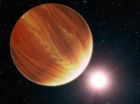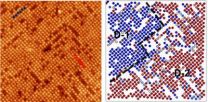(Press-News.org) Astronomers using NASA's Hubble Space Telescope have gone looking for water vapor in the atmospheres of three planets orbiting stars similar to the sun -- and have come up nearly dry.
The three planets, known as HD 189733b, HD 209458b, and WASP-12b, are between 60 and 900 light-years away from Earth and were thought to be ideal candidates for detecting water vapor in their atmospheres because of their high temperatures where water turns into a measurable vapor.
These so-called "hot Jupiters" are so close to their star they have temperatures between 1,500 and 4,000 degrees Fahrenheit, however, the planets were found to have only one-tenth to one one-thousandth the amount of water predicted by standard planet-formation theories.
"Our water measurement in one of the planets, HD 209458b, is the highest-precision measurement of any chemical compound in a planet outside our solar system, and we can now say with much greater certainty than ever before that we've found water in an exoplanet," said Nikku Madhusudhan of the Institute of Astronomy at the University of Cambridge, England. "However, the low water abundance we have found so far is quite astonishing."
Madhusudhan, who led the research, said that this finding presents a major challenge to exoplanet theory. "It basically opens a whole can of worms in planet formation. We expected all these planets to have lots of water in them. We have to revisit planet formation and migration models of giant planets, especially "hot Jupiters," and investigate how they're formed."
He emphasizes that these results may have major implications in the search for water in potentially habitable Earth-sized exoplanets. Instruments on future space telescopes may need to be designed with a higher sensitivity if target planets are drier than predicted. "We should be prepared for much lower water abundances than predicted when looking at super-Earths (rocky planets that are several times the mass of Earth)," Madhusudhan said.
Using near-infrared spectra of the planets observed with Hubble, Madhusudhan and his collaborators estimated the amount of water vapor in each of the planetary atmospheres that explains the data.
The planets were selected because they orbit relatively bright stars that provide enough radiation for an infrared-light spectrum to be taken. Absorption features from the water vapor in the planet's atmosphere are detected because they are superimposed on the small amount of starlight that glances through the planet's atmosphere.
Detecting water is almost impossible for transiting planets from the ground because Earth's atmosphere has a lot of water in it, which contaminates the observation. "We really need the Hubble Space Telescope to make such observations," said Nicolas Crouzet of the Dunlap Institute at the University of Toronto and co-author of the study.
The currently accepted theory on how giant planets in our solar system formed, known as core accretion, states a planet is formed around the young star in a protoplanetary disk made primarily of hydrogen, helium, and particles of ices and dust composed of other chemical elements. The dust particles stick to each other, eventually forming larger and larger grains. The gravitational forces of the disk draw in these grains and larger particles until a solid core forms. This then leads to runaway accretion of both solids and gas to eventually form a giant planet.
This theory predicts that the proportions of the different elements in the planet are enhanced relative to those in its star, especially oxygen, which is supposed to be the most enhanced. Once the giant planet forms, its atmospheric oxygen is expected to be largely encompassed within water molecules. The very low levels of water vapor found by this research raise a number of questions about the chemical ingredients that lead to planet formation.
"There are so many things we still don't know about exoplanets, so this opens up a new chapter in understanding how planets and solar systems form," said Drake Deming of the University of Maryland, who led one of the precursor studies. "The problem is that we are assuming the water to be as abundant as in our own solar system. What our study has shown is that water features could be a lot weaker than our expectations."
The findings are published July 24 in The Astrophysical Journal Letters.
INFORMATION:
The Hubble Space Telescope is a project of international cooperation between NASA and the European Space Agency. NASA's Goddard Space Flight Center in Greenbelt, Maryland, manages the telescope. The Space Telescope Science Institute (STScI) in Baltimore conducts Hubble science operations. STScI is operated for NASA by the Association of Universities for Research in Astronomy, Inc., in Washington.
For images and more information about Hubble, visit:
http://www.nasa.gov/hubble
and
http://hubblesite.org/news/2014/36
Hubble finds 3 surprisingly dry exoplanets
2014-07-24
ELSE PRESS RELEASES FROM THIS DATE:
The microbes make the sake brewery
2014-07-24
A sake brewery has its own microbial terroir, meaning the microbial populations found on surfaces in the facility resemble those found in the product, creating the final flavor according to research published ahead of print in the journal Applied and Environmental Microbiology. This is the first time investigators have taken a microbial census of a sake brewery.
Many sake makers inoculate with both bacteria and yeast, says corresponding author David A. Mills of the University of California, Davis, but he and his colleagues investigated a sake brewery where inoculation ...
New imaging agent provides better picture of the gut
2014-07-24
MADISON — A multi-institutional team of researchers has developed a new nanoscale agent for imaging the gastrointestinal (GI) tract. This safe, noninvasive method for assessing the function and properties of the GI tract in real time could lead to better diagnosis and treatment of gut diseases.
Illnesses such as small bowel bacterial overgrowth, irritable bowel syndrome and inflammatory bowel disease all occur in the intestine and can lead to serious side effects in patients with diseases such as diabetes and Parkinson's.
Until now, there hasn't been a good way to ...
Brain's dynamic duel underlies win-win choices
2014-07-24
People choosing between two or more equally positive outcomes experience paradoxical feelings of pleasure and anxiety, feelings associated with activity in different regions of the brain, according to research led by Amitai Shenhav, an associate research scholar at the Princeton Neuroscience Institute at Princeton University.
In one experiment, 42 people rated the desirability of more than 300 products using an auction-like procedure. Then they looked at images of paired products with different or similar values and were asked to choose between them. Their brain activity ...
TGen-led study seeks to understand why some HIV-positive men are more infectious
2014-07-24
FLAGSTAFF, Ariz. — July 24, 2014 — A new study led by the Translational Genomics Research Institute (TGen) provides insights into the interplay among bacteria, viruses and the immune system during HIV infection.
Currently, doctors measure HIV-positive men's infectivity — their potential to infect others — based on their blood viral load. However, some men produce large amounts of virus in their semen despite having low levels in their blood. Researchers call this "compartmentalization," where different levels of the virus can be found in different parts of the body; in ...
Parched West is using up underground water, UCI, NASA find
2014-07-24
Irvine, Calif., July 24, 2014 — A new study by University of California, Irvine and NASA scientists finds more than 75 percent of the water loss in the drought-stricken Colorado River Basin since late 2004 came from underground resources. The extent of groundwater loss may pose a greater threat to the water supply of the western United States than previously thought.
This study is the first to quantify the amount that groundwater contributes to the water needs of western states. According to the U.S. Bureau of Reclamation, the federal water management agency, the basin ...
ORNL study reveals new characteristics of complex oxide surfaces
2014-07-24
OAK RIDGE, Tenn., July 24, 2014 -- A novel combination of microscopy and data processing has given researchers at the Department of Energy's Oak Ridge National Laboratory an unprecedented look at the surface of a material known for its unusual physical and electrochemical properties.
The research team led by ORNL's Zheng Gai examined how oxygen affects the surface of a perovskite manganite, a complex material that exhibits dramatic magnetic and electronic behavior. The new avenue to understand surface behavior could benefit researchers who are interested in using a wide ...
Earlier Stone Age artifacts found in Northern Cape of South Africa
2014-07-24
Excavations at an archaeological site at Kathu in the Northern Cape province of South Africa have produced tens of thousands of Earlier Stone Age artifacts, including hand axes and other tools. These discoveries were made by archaeologists from the University of Cape Town (UCT), South Africa and the University of Toronto (U of T), in collaboration with the McGregor Museum in Kimberley, South Africa.
The archaeologists' research on the Kathu Townlands site, one of the richest early prehistoric archaeological sites in South Africa, was published in the journal, PLOS ONE, ...
BU researchers discover that Klotho is neuroprotective against Alzheimer's disease
2014-07-24
(Boston)—Boston University School of Medicine researchers may have found a way to delay or even prevent Alzheimer's disease (AD). They discovered that pre-treatment of neurons with the anti-aging protein Klotho can prevent neuron death in the presence of the toxic amyloid protein and glutamate. These findings currently appear in the Journal of Biological Chemistry.
Alzheimer's disease is the most frequent age-related dementia affecting 5.4 million Americans including 13 percent of people age 65 and older and more than 40 percent of people over the age of 85. In AD the ...
Creating sustainable STEM teacher preparation programs
2014-07-24
A new study has identified two factors that characterize sustainable university and college programs designed to increase the production of highly qualified physics teachers. Specifically, one or more faculty members who choose to champion physics teacher education in combination with institutional motivation and commitment can ensure that such initiatives remain viable. Science, Technology, Engineering and Math (STEM) teacher shortages are especially acute in physics, and the study points the way for institutions seeking to increase the number of STEM graduates prepared ...
'Experiential products' provide same happiness boost as experiences, study finds
2014-07-24
SAN FRANCISCO, July 24, 2014 -- Material items designed to create or enhance an experience, also known as "experiential products," can make shoppers just as happy as life experiences, according to new research from San Francisco State University.
Researchers found such products satisfy a different, but equally powerful, psychological need than experiential purchases. While life experiences help consumers feel closer to others, experiential products such as books, sporting goods, video games or musical instruments allow them to utilize and develop new skills and knowledge, ...



